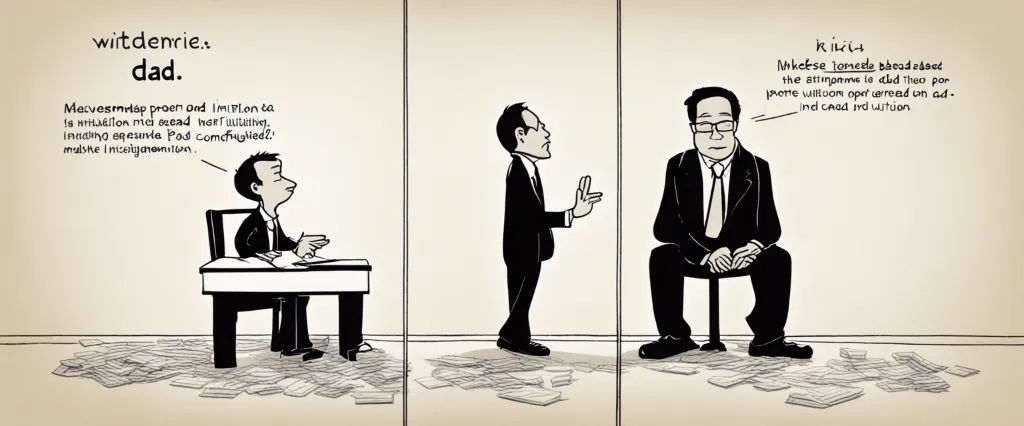In “Wisdom from Rich Dad, Poor Dad,” Robert T. Kiyosaki provides invaluable financial insights and life lessons acquired from his personal experiences, specifically the contrasting financial teachings of his two influential father figures. Kiyosaki’s internationally acclaimed book, “Rich Dad, Poor Dad,” became a bestseller and a renowned guide for achieving financial independence. Through his thought-provoking narrative, the author challenges conventional wisdom and explores the importance of financial education in building wealth. Kiyosaki’s unique perspective, stemming from his rich array of experiences as an investor, entrepreneur, and bestselling author, empowers readers to reshape their mindset and take control of their financial destiny.
Chapter 1: The Mindset of the Rich and the Poor
Chapter 1 of “Wisdom from Rich Dad, Poor Dad” by Robert T. Kiyosaki introduces the fundamental differences in mindset between the rich and the poor. The author reflects on his childhood, where he was fortunate to have two father figures – his own biological father (Poor Dad) and his best friend’s father (Rich Dad). These two men had contrasting approaches to money and life, which deeply influenced the author’s understanding of financial success.
Poor Dad, a well-educated government employee, believed that the key to financial stability was acquiring a good job with a steady income and job security. He believed in working hard, seeking promotions, and relying on pensions and benefits. However, Robert observed that despite his father’s extensive education and income from his job, his family struggled due to his father’s lack of financial intelligence.
On the other hand, Rich Dad, who had never completed high school, had a completely different mindset. He emphasized the importance of financial education, entrepreneurship, and investing. Rich Dad believed that one should strive to be financially independent and not rely on a paycheck or government benefits. He taught Robert the value of creating assets, making money work for him, and using various investment strategies to build wealth.
This chapter emphasizes the significance of mindset when it comes to wealth. The poor focus on job security and acquiring liabilities, such as expensive houses and cars, that drain their income. In contrast, the rich prioritize financial education and building assets that generate income and increase their net worth.
Overall, Chapter 1 sets the foundation for the book, highlighting the differing points of view between the rich and the poor in terms of financial intelligence, priorities, and strategies for achieving financial success. It encourages readers to adopt the mindset of the rich and seek financial education as a means to change their financial circumstances and attain wealth and independence.
Chapter 2: The Importance of Financial Education
Chapter 2 of the book “Wisdom from Rich Dad, Poor Dad” by Robert T. Kiyosaki, titled “The Importance of Financial Education,” emphasizes the significance of acquiring financial knowledge and understanding personal finances.
Kiyosaki starts by acknowledging that traditional education systems have failed to provide individuals with sufficient financial education. He believes that this lack of financial literacy is responsible for the struggles and financial hardships many people face throughout their lives.
The author emphasizes that financial education is not taught in schools because schools focus on academic and professional knowledge, not on financial intelligence. He argues that schools train students to become employees, working hard to earn a paycheck and struggling with financial problems because they lack the necessary knowledge to manage their money effectively.
Kiyosaki explains that one of the major differences between the rich and the poor is the level of financial education they possess. The wealthy understand the importance of acquiring financial knowledge, continuously expanding their understanding of how money works, and learning how to make their money work for them.
The chapter also highlights the importance of learning about different asset classes, distinguishing between assets and liabilities, and understanding the difference between working for money and having money work for you.
Kiyosaki urges readers to invest time and effort into their financial education, emphasizing that it is a lifelong learning process. By acquiring financial intelligence, individuals can gain greater control over their financial future, create wealth, and break free from the paycheck-to-paycheck cycle.
In summary, Chapter 2 underscores the necessity of financial education and how it plays a crucial role in achieving financial independence and success. Kiyosaki encourages readers to make a commitment to self-education and continually improve their financial intelligence.
Chapter 3: The Difference Between Assets and Liabilities
Chapter 3 of “Wisdom from Rich Dad, Poor Dad” by Robert T. Kiyosaki delves into the fundamental difference between assets and liabilities. The author asserts that understanding this difference is crucial for achieving financial success.
Kiyosaki begins by debunking the conventional notion that a person’s house is an asset. He argues that, contrary to popular belief, one’s home is, in fact, a liability. The primary reason for this is that it puts a strain on a person’s finances through mortgage payments, property taxes, maintenance, and other expenses. True assets, on the other hand, generate income or appreciate in value over time.
The author introduces the concept of the “cash flow pattern” to illustrate the difference between assets and liabilities. He explains that an asset provides positive cash flow since it brings in more money than it takes out, adding to a person’s wealth. Meanwhile, liabilities have a negative cash flow as they consume a person’s resources, thereby reducing their overall financial strength.
Kiyosaki encourages readers to focus on acquiring assets and avoiding or converting liabilities. He emphasizes the importance of learning to recognize opportunities to invest in assets that generate income passively, such as rental properties, stocks, bonds, or businesses. By reducing liabilities and increasing assets, individuals can achieve financial independence and build lasting wealth.
In conclusion, Chapter 3 of “Wisdom from Rich Dad, Poor Dad” highlights the crucial distinction between assets and liabilities. It promotes the idea that true assets generate income or appreciate in value, while liabilities put a strain on one’s finances. Understanding this difference and working towards acquiring more assets and minimizing liabilities can lead to financial success and freedom.
Chapter 4: Creating Passive Income

Chapter 4 of “Wisdom from Rich Dad, Poor Dad” by Robert T. Kiyosaki is titled “Creating Passive Income” and focuses on the concept of generating passive income and how it contributes to financial independence.
Kiyosaki begins by explaining that passive income is crucial in breaking free from the typical 9-to-5 mindset and becoming financially independent. He emphasizes the importance of creating income streams that do not require active effort or time, allowing individuals to have more freedom and flexibility in their lives.
The author introduces the concept of assets and liabilities, emphasizing that assets generate income while liabilities drain it. He emphasizes that acquiring assets, such as stocks, bonds, intellectual property, or real estate, is essential in creating passive income. Passive income can help individuals cover their expenses without relying solely on active income from a job.
Kiyosaki delves into the different categories of income earners: employees, self-employed, business owners, and investors. He highlights that the goal is to transition from being an employee or self-employed individual to becoming a business owner or investor who generates passive income. This shift requires a mindset change and a focus on acquiring assets that produce cash flow.
Additionally, the author discusses the importance of financial education and understanding the difference between good and bad debt. He promotes the idea of leveraging good debt to acquire income-generating assets, rather than being burdened by bad debt, which is incurred for liabilities.
In summary, Chapter 4 of “Wisdom from Rich Dad, Poor Dad” emphasizes the significance of creating passive income to achieve financial independence. It stresses the need to acquire income-generating assets, transition from being an employee to a business owner or investor, and make informed financial decisions.
Chapter 5: The Advantages of Investing in Real Estate
In Chapter 5 of “Wisdom from Rich Dad, Poor Dad” by Robert T. Kiyosaki, titled “The Advantages of Investing in Real Estate,” the author highlights the benefits of investing in real estate as opposed to other forms of investment.
Kiyosaki starts by explaining that in real estate investing, one can acquire assets that generate cash flow while simultaneously building equity. He emphasizes that the key to success is understanding the power of leverage, using other people’s money to finance investments. By financing properties with loans and collecting rental income, investors can enjoy the benefits of increasing property values and paydown of debt, resulting in substantial profits in the long run.
Furthermore, the author discusses the advantages of real estate over other types of investments, such as stocks. Unlike stocks that can be highly volatile and subject to market fluctuations, real estate values tend to be more stable over time. Kiyosaki also highlights the tax advantages and deductions that come with owning real estate, allowing investors to save on taxes and increase their overall cash flow.
In addition, the chapter emphasizes the role of education and knowledge in real estate investing. Kiyosaki advises readers to learn about different real estate strategies, including residential and commercial properties, as well as understanding market cycles, financing options, and property management techniques. Having the necessary knowledge and skills can help investors make informed decisions and maximize their returns.
Overall, this chapter emphasizes the numerous advantages of investing in real estate, including cash flow, equity building, leverage, stability, tax advantages, and the importance of continuous learning in order to succeed in this field.
Chapter 6: Creating a Financial Plan
In Chapter 6 of the book “Wisdom from Rich Dad, Poor Dad” by Robert T. Kiyosaki, the author emphasizes the importance of creating a financial plan and discusses various elements that should be included in it.
Kiyosaki begins by stressing that having a financial plan is crucial for achieving financial independence and wealth. He advises that individuals should start by identifying their financial goals and aspirations. These goals can range from achieving a certain income level to owning real estate or starting a business. By clearly defining these objectives, individuals can better structure their financial plan around them.
Next, Kiyosaki introduces the concept of creating multiple income streams. He highlights the significance of not relying solely on a single source of income, such as a job, as it can be unstable and limit financial growth. Instead, he suggests diversifying income by investing in real estate, stocks, or businesses, which can generate passive income and provide financial security.
Furthermore, Kiyosaki suggests that individuals should focus on building assets rather than acquiring liabilities. Assets, such as properties or businesses, generate continuous cash flow and appreciate in value over time. On the other hand, liabilities, such as consumer debts or luxury purchases, drain resources and offer no financial return.
The author emphasizes the need for financial education to make informed decisions. He encourages readers to invest time and effort into learning about money management, investing, and financial strategies. By acquiring financial intelligence, individuals can make better financial decisions and increase their chances of success.
In conclusion, Chapter 6 explores the significance of creating a financial plan. It emphasizes the importance of setting clear financial goals, diversifying income streams, building assets, and acquiring financial education. Kiyosaki’s insights encourage readers to take control of their financial future and create a roadmap for achieving wealth and financial independence.
Chapter 7: Understanding Taxation
Chapter 7: Understanding Taxation in the book Wisdom from Rich Dad, Poor Dad by Robert T. Kiyosaki delves into the importance of understanding the taxation system and how it affects our financial well-being. Kiyosaki highlights the stark contrast between the mindsets of the rich and the poor when it comes to taxes.
The chapter starts by explaining that employees and the self-employed often pay the highest percentage of their income in taxes due to being taxed on their earnings before they can even cover their expenses. On the other hand, the rich have a different approach. They utilize various legal tax strategies and take advantage of tax loopholes that minimize their tax liability. This is possible because they understand how to make money work for them and maintain control over their financial decisions.
Kiyosaki emphasizes the importance of financial education in understanding the tax system. He points out that tax laws are often created to benefit business owners and investors who take risks and create jobs. By understanding these laws and utilizing them to their advantage, individuals can legally minimize their tax burden and have more money to invest in income-generating assets.
The author further highlights the concept of “pay yourself first” when it comes to taxes. He advises readers to immediately save or allocate a portion of their income for investing before taxes are deducted. By doing this, individuals shift the mindset from focusing on paying bills to prioritizing wealth creation.
In summary, Chapter 7 of Wisdom from Rich Dad, Poor Dad emphasizes the importance of understanding the taxation system. It encourages readers to shift their mindset, learn about tax laws, and utilize legal strategies to minimize tax burdens. By doing so, individuals can increase their financial intelligence and have more money available for investing, ultimately leading to financial freedom and wealth creation.

Chapter 8: Investment Strategies of the Rich
Chapter 8 of “Wisdom from Rich Dad, Poor Dad” by Robert T. Kiyosaki focuses on investment strategies commonly used by the rich. Kiyosaki emphasizes the importance of understanding different types of investments and the mindset required to become wealthy.
The chapter begins by discussing the mindset that separates the rich from the rest. Kiyosaki explains that the rich think in terms of generating passive income, which allows them to achieve financial freedom. This is in stark contrast to the poor and middle class, who rely primarily on active income from their jobs.
Kiyosaki then introduces the concept of multiple streams of income, stating that the rich diversify their investments to minimize risk and increase their chances of building wealth. He advises against solely relying on a single source of income, such as a job or a single business.
The author proceeds to explain various investment options that the rich commonly explore. These include investing in real estate, starting or acquiring businesses, investing in paper assets like stocks and bonds, and investing in commodities such as gold and silver. Kiyosaki emphasizes the importance of education and understanding these different investment options before making any decisions.
Furthermore, he promotes the idea of investing for cash flow rather than focusing solely on capital appreciation. This means seeking investments that provide a steady stream of income, such as rental properties or dividend-paying stocks, to cover ongoing expenses and maintain financial stability.
In conclusion, Chapter 8 of “Wisdom from Rich Dad, Poor Dad” delves into the investment strategies of the rich. Kiyosaki highlights the importance of adopting a wealth mindset, diversifying income streams, and being knowledgeable about various investment options. By implementing these strategies, individuals can increase their chances of achieving financial independence and building lasting wealth.
After Reading
In conclusion, “Wisdom from Rich Dad, Poor Dad” by Robert T. Kiyosaki provides valuable insights and practical advice on achieving financial success and independence. The book emphasizes the importance of financial education and developing the right mindset towards money. Kiyosaki’s personal anecdotes and clear explanations make complex financial concepts easy to understand for readers of all backgrounds. By challenging conventional beliefs and sharing his own experiences, Kiyosaki encourages readers to think outside the box and take control of their financial destiny. Overall, “Wisdom from Rich Dad, Poor Dad” is a must-read for anyone seeking to improve their financial literacy and achieve financial freedom.
1. The Intelligent Investor” by Benjamin Graham
Best known as the mentor of Warren Buffett, Benjamin Graham provides valuable insights into the world of investing. This book offers timeless wisdom on value investing, risk management, and the importance of a disciplined approach to wealth creation.
2. The Millionaire Next Door” by Thomas J. Stanley and William D. Danko
Stanley and Danko take a deep dive into the habits and characteristics of self-made millionaires. Through extensive research, they debunk common misconceptions about wealth and provide practical advice on building financial independence from an average income.
3. Think and Grow Rich” by Napoleon Hill
Considered a classic in the realm of personal development, Hill explores the mindset required for success. Drawing wisdom from interviews with the most successful individuals of his time, this book uncovers the principles and strategies needed to achieve financial abundance.
4. The Richest Man in Babylon” by George S. Clason
Set in ancient Babylon, this book uses parables to impart timeless financial advice. Clason reveals the secrets to accumulating wealth, managing finances, and developing a prosperous mindset, all presented in an engaging and accessible manner.
5. The 4-Hour Workweek” by Timothy Ferriss
Ferriss challenges traditional notions of success and encourages readers to redesign their lives around their unique passions and goals. Providing practical tips and innovative strategies, this book shows how to achieve financial freedom by leveraging technology and creating multiple income streams.
Each of these books offers valuable insights, strategies, and lessons about personal finance and wealth creation. Whether you are a beginner or an experienced investor, these titles provide a solid foundation for building financial intelligence and achieving long-term success.




